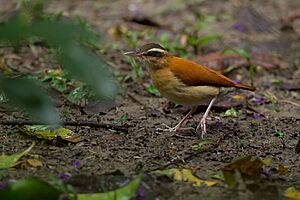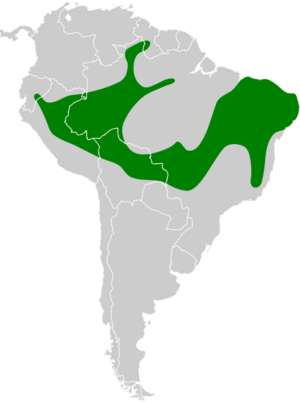Pale-legged hornero facts for kids
Quick facts for kids Pale-legged hornero |
|
|---|---|
 |
|
| Conservation status | |
| Scientific classification | |
| Genus: |
Furnarius
|
| Species: |
leucopus
|
 |
|
The pale-legged hornero (scientific name: Furnarius leucopus) is a fascinating bird found in parts of South America. It belongs to the ovenbird family, known for building unique, oven-shaped nests. You can spot this bird in countries like Bolivia, Brazil, Guyana, and Peru.
Contents
Discovering the Pale-legged Hornero's Family
Scientists study birds to understand how they are related. For the pale-legged hornero, different groups of scientists sometimes have slightly different ideas about its family tree. Most experts agree that there are four main types, or subspecies, of the pale-legged hornero. These are like different varieties within the same species.
- F. l. leucopus
- F. l. tricolor
- F. l. araguaiae
- F. l. assimilis
Sometimes, what one group calls a subspecies, another group might consider a completely separate species! For example, some scientists think the Pacific hornero and Caribbean hornero are distinct species. They were once thought to be types of the pale-legged hornero. In this article, we will focus on the four main subspecies listed above.
What Does the Pale-legged Hornero Look Like?
The pale-legged hornero is a medium-sized bird, usually about 15 to 18 centimeters (6 to 7 inches) long. It weighs around 37 to 49 grams (1.3 to 1.7 ounces). This is about the weight of a small candy bar. It has a long, almost straight beak. Both male and female birds look very similar.
This bird has a wide, whitish stripe above its eye, like an eyebrow. Its cheeks are brownish-gray, and the area below its eye is a reddish-brown color. The top of its head is a dark reddish-brown. Its back and rump are a bright orange-red, but this color can vary a bit. Its tail is a rich chestnut color.
The wings have chestnut-colored feathers. The flight feathers are blackish with a wide chestnut band. Its throat is white, fading into a yellowish-brown on its chest. The sides of its body are a lighter yellowish-brown, and its belly is almost white.
The bird's eyes are usually reddish-brown or chestnut. Its beak is dark at the base and lighter at the tip. True to its name, its legs and feet are pale pinkish, pearly gray, or whitish. Young pale-legged horneros look like the adults but have a shorter beak.
Different subspecies have slight color variations:
- The F. l. tricolor subspecies has a grayer head and more yellowish-brown back.
- F. l. assimilis has a lighter, more yellowish-brown rump, wings, and tail.
- F. l. araguaiae is a mix between tricolor and assimilis, with a brighter back.
Where Do Pale-legged Horneros Live?
The pale-legged hornero lives in various parts of South America. Each subspecies has its own specific areas:
- F. l. leucopus: Found along the Negro and Branco rivers in northern Brazil and in southwestern Guyana.
- F. l. tricolor: Lives in eastern Peru, western Brazil (extending into Pará state), and into Bolivia (to Santa Cruz Department). There was also one sighting in southeastern Ecuador.
- F. l. araguaiae: Found in western Tocantins and eastern Mato Grosso states in central Brazil, along the Araguaia and das Mortes rivers.
- F. l. assimilis: Lives in eastern and southern Brazil, between Maranhão, Pernambuco, and Mato Grosso do Sul, and in the very southeastern part of Bolivia.
These birds like many different kinds of open or semi-open places. You can find them in forests along rivers, at the edges of new forests growing back, in farm areas, and even in parks and gardens in towns. They especially love humid areas, usually close to water. They mostly live below 1,100 meters (3,600 feet) in elevation. However, they sometimes can be found as high as 1,700 meters (5,600 feet) in Peru.
How Pale-legged Horneros Live
Movement and Travel
Pale-legged horneros usually stay in the same area all year round. They don't migrate long distances like some other birds. Sometimes, they might move short distances, perhaps following rivers, or exploring new areas.
What Do Pale-legged Horneros Eat?
Their diet mainly consists of different kinds of arthropods. These are creatures like insects and spiders. They also eat other small invertebrates, such as snails. There is even one record of a hornero eating a small toad! They search for food alone or in pairs, walking on the ground and flipping over leaves to find their prey.
Reproduction and Life Cycle
Scientists don't know a lot about the pale-legged hornero's breeding habits. This is surprising for a bird that is quite common and easy to spot! We don't have an exact breeding season defined for them yet.
However, we do know about their amazing nests. They build a special "oven" nest made of clay and animal dung. Inside, they line it with dry plant material to make it cozy. Both the male and female birds work together to build this nest. They usually place it on a tree branch. Sometimes they build it on flat surfaces like the crossbars of utility poles.
We don't know how many eggs they lay (their clutch size). At one nest in Peru, the eggs hatched after 16 to 17 days. The young birds stayed in the nest for 26 to 33 days before they were ready to fly. Both parents helped feed the baby birds.
How Pale-legged Horneros Communicate
The pale-legged hornero has a very loud and distinct song. It's a long series of quick, sharp notes that start fast and then slow down, getting lower in pitch. Imagine hearing something like PIPIPI'PI'pi'pi-pi-pi-pi-pi pee pee pu! They also make calls that sound like a loud, scratchy chet or kyeek, or a descending cheeop.
Protecting the Pale-legged Hornero
The IUCN (International Union for Conservation of Nature) has evaluated the pale-legged hornero. It considers it a species of "Least Concern." This means they are not currently at risk of disappearing. They live across a very large area. Even though we don't know their exact numbers, their population is thought to be growing.
No immediate threats have been found for these birds. They are considered to be anywhere from uncommon to very common in different places. In fact, they actually benefit from some changes humans make to their habitat, like clearing forests. They have even expanded their range into areas where forests have been removed. They also live in several protected natural areas.


